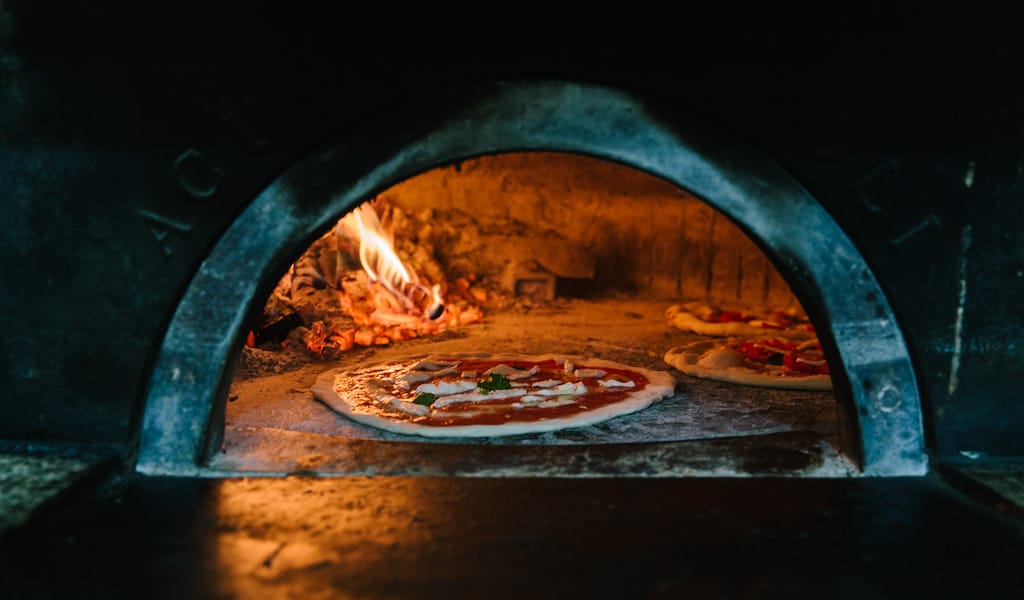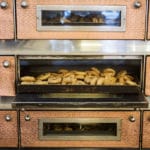The birthplace of pizza, Naples is awash with unbeatable pizzerias. Don’t want to miss out on the perfect pie? Culinary Backstreets has you covered. Our team of locals has handpicked the best of the best pizza in Naples, highlighting the art of the city’s pizzaiolos – now recognized on the list of UNESCO Intangible Cultural Heritage. Below is a selection of our absolute favorites:
Brandi Pizzeria: The Original
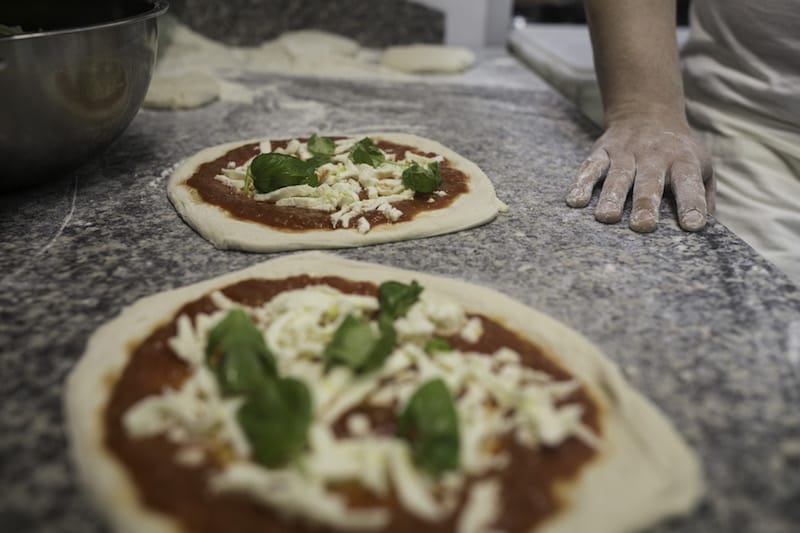
Raffaele Esposito and his wife Giovanna Brandi took over what was once Pietro’s pizzeria, Naples’s first pizza joint, as legend would have it. Diving deeper into pizza mythology, it is the summer of 1889 and the Savoy royals are in Naples. Queen Margherita is housed in the Palace of Capodimonte. As the story goes, tired of the palace’s fussy French cuisine, the queen expresses a desire to taste “the famous Neapolitan pizza.” So, a palace official sends out an invitation for Raffaele to come through with his classic pies.
He makes three types for the occasion. The first, a white pizza, with oil, pork lard, cheese and basil. The second, with cecenielle (whitebait). The third represents the tri-colored Italian flag: white mozzarella, green basil and red tomato. You can guess which one was just right for Queen Margherita. Thus, the Pizza Margherita was baptized into legend.
The 21st-century pizza Margherita coming out of Brandi’s oven is still extraordinary, using the best San Marzano tomatoes, dairy products from Agerola on the Sorrento Amalfi Coast, basil of the Vesuvian villages and sublime extra virgin olive oil from Campania. Worth a stop for its place in pizza history.
Isabella De Cham Pizza Fritta: The Pizza Queen
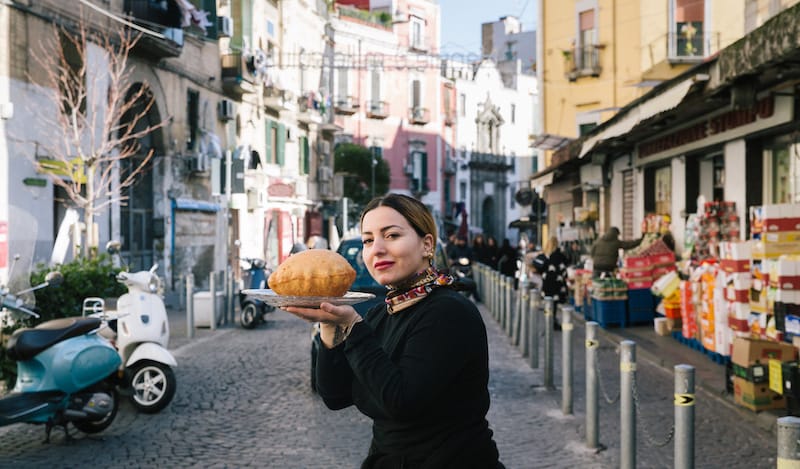
When in the Sanità neighborhood, there’s no question that we’ll be seeking out the fried pizza of Isabella De Cham. The young chef makes creative and high-quality fried foods in an elegant and polished restaurant, with a black-and-white color scheme – not quite what you’d expect for a fried pizza joint, although the familiar warmth is still there. Here, the standard fried pizza is filled with pork crackling, ricotta, pepper and basil; we always choose this classic filling because we believe it is the pizza on which all pizza makers should be measured. Isabella’s is divine.
The entire process, from start to finish, is overseen by women – fried pizza has long been their domain, so we know that they have an edge. Susanna takes care of the friers, Alessandra is the handy(wo)man and Isabella’s right hand, Imma is the wine specialist, Ilaria makes the dough, and Antoniette, a true orchestra conductor, oversees the cash desk. But that’s just the tip of the iceberg – there are 20 employees in total at this small business.
In 2018, Isabella decided to challenge the sacred masters of the Neapolitan pizza world by opening her own fried pizza spot. It was a risk that paid off – today she is one of the best-known pizza makers in Naples and has even expanded, opening a second Isabella De Cham Pizza Fritta in the Montesanto market (Via Portamedina 53).
Pizzeria Cafasso: The Superstar
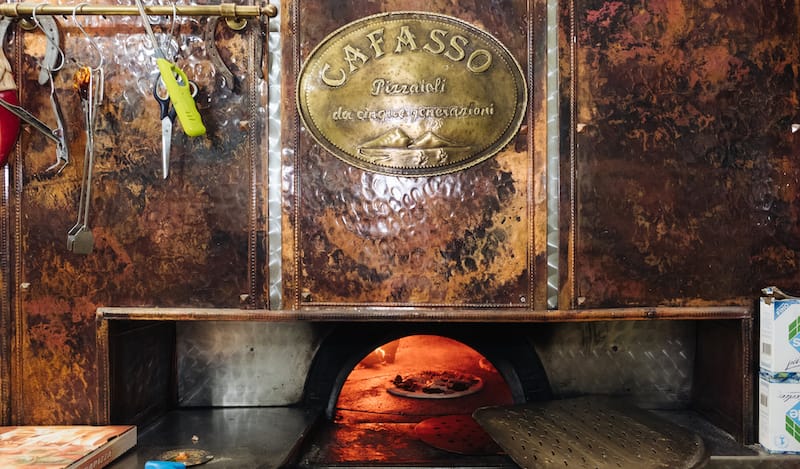
On the outskirts of Naples, in the residential suburb of Fuorigrotta, Pizzeria Cafasso manages to attract famous directors and the average Joe alike (it’s still easily accessible by train). But we would argue that the pursuit of quality always pays off – excellent pies are what make the simple, family-run pizzeria one of the best known in the city. Co-owner Ugo is proud of maintaining a high level of excellence. “I have received extraordinary awards,” he tells us, including visits from some of Italy’s most celebrated artists. “Paolo Sorrentino, the director of the film ‘La grande bellezza’ (‘The Great Beauty’), came here after winning the Oscar in 2014, together with actor Tony Servillo, to celebrate the victory.”
The rules written by Don Peppino are still in place: The mixture of flours remains the same, and the size of the pizza – not too big – is consistent. Above all, their pies are never too dry and have a solid structure. Out of these principles was born the calzone stuffed with escarole, a true symbol of the place. It’s balanced and delicious, with the secret being the addition of a generous portion of pecorino Romano and olive oil on the outside. As it cooks, a sensual crust of cheese and oil forms on the surface of the calzone.
Pizzeria ‘Ntretella: The Newcomer
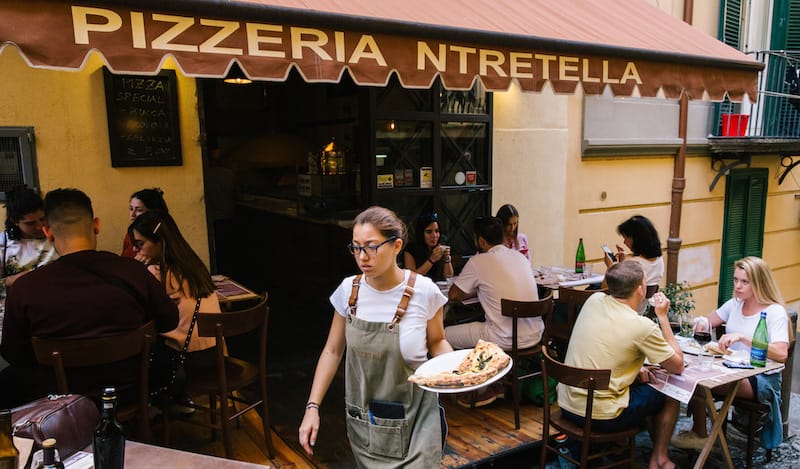
Opening a pizza joint in a city that’s world renowned for its pies requires some gumption. Maria Rosaria Artigiano, the energetic owner of Pizzeria ‘Ntretella, which opened in 2016, certainly has it; so does her brother, the brilliant chef Gennaro Artigiano. The beautiful restaurant they built together in the Spanish Quarter has quickly become a “new classic” in the panorama of Neapolitan pizzerias. Mass tourism has completely transformed the Spanish Quarter, making it a popular and crowded destination, a maze of narrow streets full of restaurants, pizzerias and numerous magical corners to discover.
Pizzeria ‘Ntretella is one of the quarter’s surprises. The name comes from Neapolitan puppetry: Traditionally Ntretella is the girlfriend of Pulcinella, one of the genre’s stock characters. Equally as traditional as its name is Ntretella’s pizza, which is made using slow-rise dough. “We let it rise for at least 48 hours, and this guarantees a great lightness to the dough,” says Maria Rosaria. “The ingredients are all of exceptional quality – we use various Slow Food products, such as ancient Neapolitan tomatoes.” We order several pizzas to try a slice of them all. As always, we find the pizza marinara, made simply with tomato, garlic and oregano, to offer the strongest tomato flavor – it’s the best way to enjoy this elemental ingredient. Here there is a very interesting version made with anchovies from Pozzuoli.
Pizzeria Da Attilio: The Star-Shaped Pie
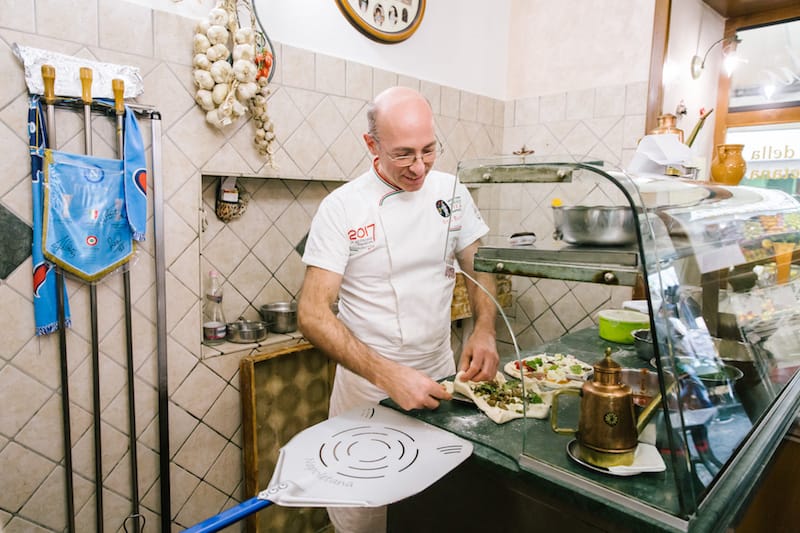
In a sector – that is, the Neapolitan pizza scene – where it is believed that everything has been said by now, Attilio is a pizzeria that has always loved to innovate. While the restaurant was undergoing renovations sometime in the 90s, Attilio uncovered a menu from the 40s. He saw that his grandfather (also Attilio) had been serving a particular pizza: Carnevale (carnival), a star-shaped pie. So, Attilio the junior decided to bring it back. The eight-pointed ricotta-filled star frame, stuffed with sausage, sauce and fior di latte, is just like the “carnival lasagna,” traditionally served as a meaty splurge before Lent, from which it takes its name.
But Attilio didn’t stop there. He created other star-shaped pizzas that are now his claim to fame: the pizza giardiniera, also eight-points stuffed with a mix of grilled and sautéed vegetables and funghi; and the pizza Appennini, with ricotta, provola and zucchini. Certainly you’ll find other just-as-delightful classic round pizzas on the menu: a pizza with Vesuvian piennolo tomatoes and smoked provola; the Attilio pizza, which is known for its combination of nine flavors; the Fiore pizza; and many others. They are all linked by a common characteristic of which Attilio is most proud – lightness. “My greatest happiness? When a child eats all the pizza and then tells his parents, ‘I would like more,’” Attilio tells us as he takes his pizzas out of the oven. “And if a child says so, this means my pizza is really light.”
Cantina del Gallo: The Multigenerational Marvel
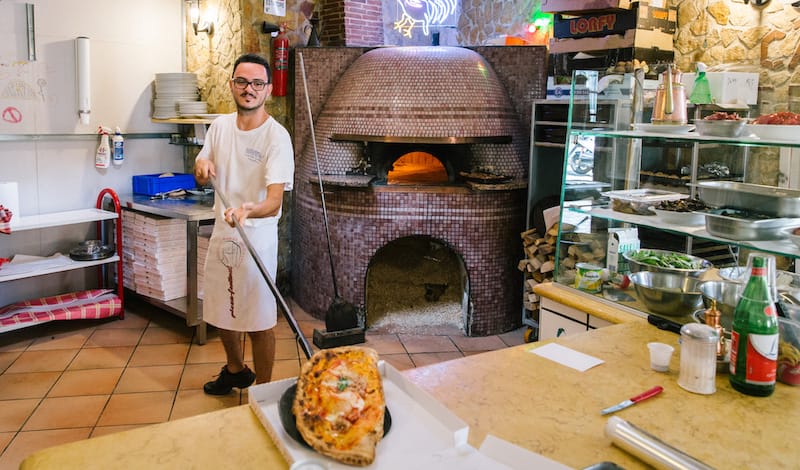
We’ve got a thing for small, family-run spots in Naples, particularly those that are multigenerational. If a restaurant or bakery or producer has been open for at least a century and has always stubbornly stood in the same place, continuity and quality of product are all but guaranteed. Take, for instance, Cantina del Gallo in Materdei. Established in 1898 and run by four generations of the Silvestri family, this is one of the few real outdoor taverns left in Naples. Over the years, this cozy, simple spot has attracted artists, intellectuals, musicians, travelers and many Neapolitan students looking for good food at reasonable prices.
Chef, pizzaiolo and owner Rosario Silvestri is always at the center of the scene. He’ll greet you with hands covered in flour, talking constantly, whether or not you understand Italian. Gesticulating cheerfully, he’ll explain the quality of the ingredients he uses. “Look at this flour I use, it’s excellent,” he tells an American guest who obviously does not understand a word. “Smell this tomato: it’s the best, the real San Marzano.”
There are three dishes that are the restaurant’s workhorses, and the ones we always seem to rotate between: the pennette alla sorrentina (a variation of the classic gnocchi alla sorrentina, seasoned with tomato, basil and stringy mozzarella), the baked cod (although the fried cod is just as mouth-watering) and the pizza cafona (peasant pizza), topped with oregano, cheese, chile and with double the tomatoes (tomato juice and chopped tomatoes). The cantina began as a store selling bulk wine and oil. It was only in the 1950s, when the legendary Aunt Cuncetta began cooking, that it became the simple and genuine tavern it is today.
Pizzeria e Trattoria Vigliena: The Seafood Special
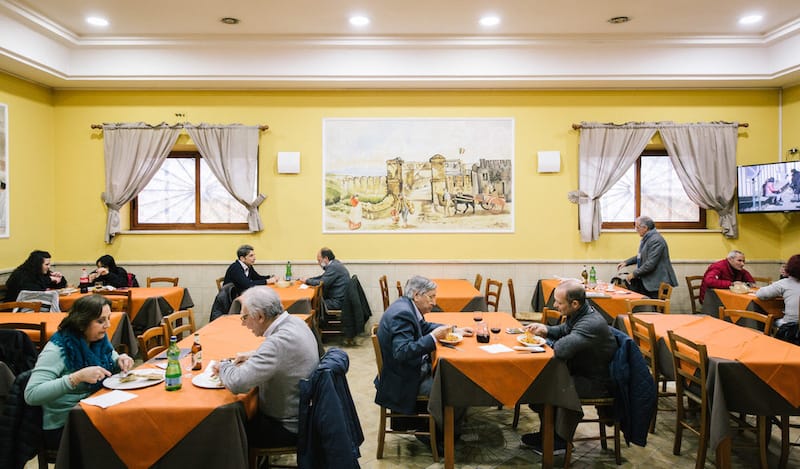
One day, or so the story goes, a group of tourists asked an elderly priest in Naples which churches were really worth visiting. The priest replied, “There are many churches, but have you tried the spaghetti with clams?” An interesting way to recommend a pizza spot, to be sure, but we are all about the clams at Pizzeria e Trattoria Vigliena. And what better way to sop up the leftover sauce from this unparalleled dish than with a slice of pizza? On the suggestion of the owner Raffaele Esposito, we ordered a plain pie to dip into our spaghetti with clams, and now the two dishes are forever entwined.
In the kitchen, mama Concetta prepares the miraculous spaghetti with clams (although her spaghetti with octopus, pasta and potatoes, and pasta and beans are equally famous). Raffaele is Concetta’s son, and the third generation of a family of chefs who founded this restaurant in the middle of the 20th century. We often find him at the pizza counter (and yes, the pizza here is fantastic), while his wife, Susy, can be found behind the cash register. At lunch, the place is packed with workers from the docks and ship owners and workers from the recently built Marina Vigliena.
Pizzeria Gino Sorbillo: The Classic
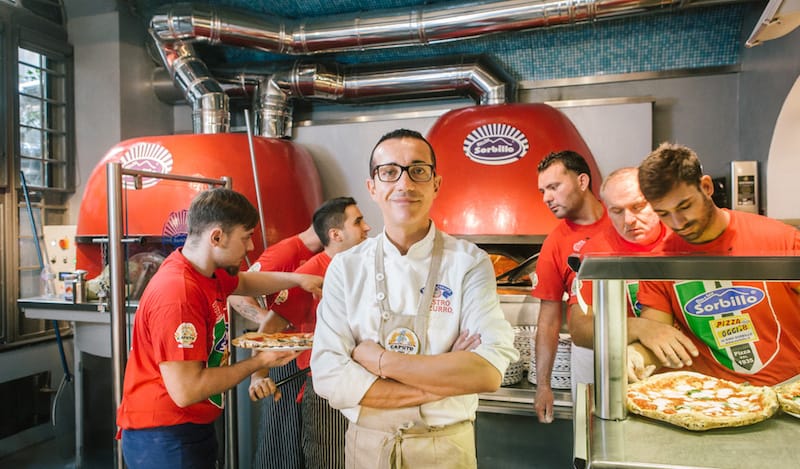
Gino Sorbillo, the man behind the eponymous Pizzeria Gino Sorbillo, belongs to one of the oldest pizza-making families in Naples, as far back as 1935. In honor of that lineage, 21 of the 23 pizzas served at Sorbillo’s are named after his father and his father’s 20 siblings (all pizzaiolos). The other two are dedicated to his fruitful paternal grandparents. Take the Raimondo: Along with top-shelf arugula, ham and parmesan cheese, it is also topped with artisanal tomatoes from Mount Vesuvius (Pomodorino del piennolo). For something more decadent, we order the Luigi, a fried pizza filled with cigoli, compressed pieces of fatty pork (the higher the calories, the better it tastes).
With such a pizza-rich past, it’s no wonder that he makes some of the best pizza in Naples. Unfortunately for us, the rest of the city shares this high opinion of Gino’s pizzas. Which is why, on most days, you can find crowds of customers waiting – sometimes up to an hour – to get into the restaurant.
Friggitoria Masardona: The Fried Favorite

Yes, Naples is the birthplace of pizza – but before the baked variety we all know and love came to be, fried pizza was the norm. Try it at no other than Masardona’s fry house, immortalized in the movie “The Gold of Naples,” starring Sophia Loren as a pizza seller. As in the film, Enzo Piccirillo and his sons prepare the dough and his wife fries the pizza to perfection. They produce just one thing: fried pizza, made of a light dough enclosing a mixture of ricotta, cicoli (fatty pork), provola cheese and tomato. A bit of pepper is added, and then Enzo punches all around the sides of the pizza to ensure that the filling won’t leak. A few skillful, fast movements – part of the family legacy – and the pizza is immersed in hot oil for what seems like only a few seconds. After a few deft spins by the wife at the fryer, the pizza is ready, scorchingly hot, delicious. For those who can’t finish a full pie, there’s the battilocchio, a half portion. There’s not much in the way of seating at the pizzeria, just a few stools inside and a couple of tables on the small sidewalk outside.
Enzo’s sons are the fourth generation of a family that has been operating this fry house since 1947. The founder was Anna’s grandmother (nicknamed “Masardona”); then Carmela took over, and now there’s Enzo, Carmela’s son, the wise entrepreneur, the philosopher of fried pizza, who carefully ensures that each of the pizzas produced meets his very high standards. Fried pizza might have always been around, but Enzo knows that only consistently high quality will ensure that his family’s business will last.
Trattoria Pizzeria Caravaggio: The Charmer

In 2017, when Francesco Cancelliere and his brother-in-law Oreste Improta opened their small trattoria in Piazza Cardinale Sisto Riario Sforza, a splendid little-known square behind Cattedrale di San Gennaro, they drew inspiration from a nearby masterpiece: Caravaggio’s The Seven Works of Mercy, which was made for, and is still housed in, the church of Pio Monte della Misericordia, located close to the cathedral.
A year after setting up the trattoria, they opened a small pizzeria just 20 meters away, on Via Tribunali, that also goes by the name Caravaggio. Diners can order both from the trattoria and the pizzeria. “We just send the order by telephone to the guys who are in the pizzeria,” Francesco says. The Caravaggio pizza, topped with swordfish, is particularly popular. The clientele is mainly made up of Neapolitans who love traditional cuisine. But there is no shortage of tourists – actually, more discerning travelers, explorers in search of particular places, rather than tourists. Both are finding their way back to the restaurant, attracted by the powerful combination of excellent food and a beautiful setting. Such is the pull of a charming Italian piazza.
Antica Pizzeria Prigiobbo: The Time Machine
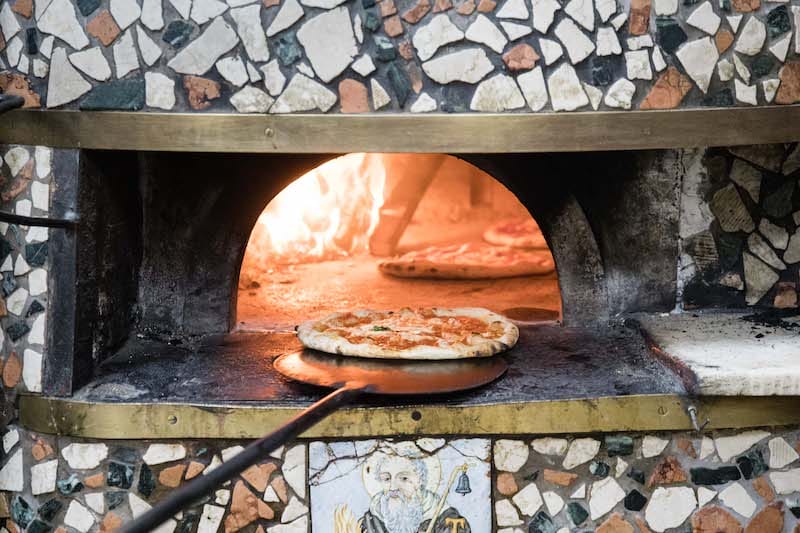
Prigiobbo has been declared a place of historical importance by the Municipality of Naples. In fact, everything about it seems to be the same as it must have been 100 years ago. Forget those pizza chefs who have become TV stars. Away from the media spotlight, the brothers Prigiobbo make pizza the simplest – and most ancient – way, as pizza should be. The shop, once a grocery store called Olio e Legumi (oil and legumes), became a wine canteen with a tavern when World War I ended. After World War II, the pizzeria business was added. The wood-burning oven is a post-war relic, made by quality craftsmen and adorned with a ceramic tile featuring the likeness of Saint Anthony the Abbot, the patron saint of pizza makers, fire fighters and pigs.
The list of pizzas is limited, which is always a good sign. We order what is a very good margherita – with “a shade of tomato,” according to the Prigiobbo brothers – to honor the pizza born here in the Spanish quarter. Here is a neighborhood institution that has had the same heart and soul for almost 100 years.
Published on April 15, 2024
Related stories
May 26, 2017
NaplesThe rustic Neapolitan tarallo, made of 'nzogna (lard), pepper and toasted almonds, is a true delicacy. It can be considered the first popular snack in Naples, a bite that combines the punch of black pepper with the sweetness of almonds, the whole united by lard. It’s a dangerous combination for the waistline, that’s for sure. Taralli are offered…
July 9, 2020
MarseilleWith its temperate climate, extensive coastline and friendly character, Marseille has all the ingredients for prime picnicking. The sun shines over 300 days a year. Winter temperatures hover in the 50s and 60s while summer’s late sunsets let daylight linger until 10 p.m. Marseille’s 26 miles of coastline are peppered with rocky coves, sandy beaches…
November 28, 2023
TokyoThe Gion district of Kyoto embodies the romanticism that surrounds Japan’s ancient capital. Filled with machiya (traditional long wooden houses), it harbors several “teahouses,” where geiko — the Kyoto term for geisha – entertain their high-class guests with quick-witted conversation and skilled musical performances. Yet just north of Shijo Street, the neighborhood evolves into a…







































